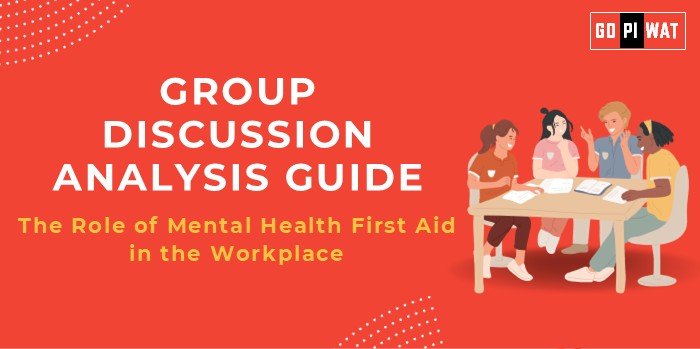📋 Group Discussion Analysis Guide: The Role of Mental Health First Aid in the Workplace
🌟 Introduction to the Topic
Opening Context: Mental health first aid (MHFA) in the workplace addresses the increasing need to manage mental well-being as part of comprehensive employee health. Globally, organizations face challenges such as burnout, stress, and depression, making MHFA programs crucial for sustainable productivity and employee satisfaction.
Topic Background: Introduced in Australia in 2000, MHFA aims to equip individuals with skills to identify, support, and guide colleagues experiencing mental health issues. The adoption of workplace MHFA has accelerated recently due to pandemic-induced mental health crises.
📊 Quick Facts and Key Statistics
- 📈 Workplace Stress Prevalence: 89% of employees in India report experiencing workplace stress (2023, Optum Survey).
- 💰 Mental Health Costs: Global economic cost of mental disorders projected at $16 trillion by 2030 (World Economic Forum).
- 📋 MHFA Certification Growth: Over 4 million people certified globally in MHFA (2024).
- 🔄 Employee Retention Impact: Companies with mental health programs report 20% higher retention rates.
🤝 Stakeholders and Their Roles
- Employers: Develop and fund MHFA programs; foster a supportive culture.
- Employees: Engage in training and utilize resources.
- Healthcare Providers: Offer MHFA certifications and therapeutic resources.
- Government and NGOs: Advocate for policies and funding for workplace mental health.
✅ Achievements and Challenges
🎉 Achievements:
- Increased Awareness: MHFA-trained workplaces report a 35% reduction in stigma.
- Improved Productivity: Companies adopting MHFA see a 12% rise in overall productivity.
- Global Adoption: Notable programs in Australia, Canada, and the UK.
⚠️ Challenges:
- Limited Access: Only 10% of Indian firms offer structured mental health support.
- Stigma: Employees often fear judgment, reducing participation.
- Resource Gap: Insufficient trainers and certified professionals in developing regions.
🌍 Global Comparisons:
- Australia: MHFA is part of national workplace safety standards.
- Canada: Successful integration in healthcare and education sectors.
📚 Case Studies:
- Tata Steel, India: Employee assistance program resulting in a 15% reduction in absenteeism.
- Microsoft: Comprehensive mental health program, including MHFA, enhanced employee satisfaction scores by 20%.
🛠️ Structured Arguments for Discussion
- Supporting Stance: “Mental health first aid ensures early intervention, reduces stigma, and enhances organizational resilience.”
- Opposing Stance: “MHFA alone is insufficient without systemic policy changes and robust mental health insurance.”
- Balanced Perspective: “While MHFA is a significant first step, its success depends on holistic mental health strategies.”
🗣️ Effective Discussion Approaches
- Opening Approaches:
- 💡 Highlight Cost Implications: “Untreated mental health issues could cost the global economy $16 trillion by 2030.”
- 📖 Share a Success Story: “Australia’s MHFA integration highlights how mental health policies improve workplace outcomes.”
- Counter-Argument Handling:
- Backed by data, rebut concerns about program effectiveness and emphasize the need for complementary systemic reforms.
🔍 Strategic Analysis of Strengths and Weaknesses
- Strengths: Reduces stigma, early identification of issues, boosts morale.
- Weaknesses: Limited reach, potential reliance on untrained peers.
- Opportunities: Integration with digital health platforms.
- Threats: Organizational resistance, confidentiality concerns.
🎓 Connecting with B-School Applications
- Real-World Applications: Integration of MHFA into HR policies and sustainability frameworks.
- Sample Interview Questions:
- “What is the role of mental health in enhancing organizational productivity?”
- “How can companies balance mental health initiatives with business goals?”
- Insights for B-School Students:
- MHFA offers insights for projects in organizational behavior and HR strategy.
- Internships in companies pioneering workplace wellness provide real-world learning.


